| Abutilon [Abutilon x hybridum]
|
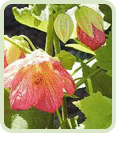 Zone 8 – 10 Zone 8 – 10Light: Full Sun to Partial Shade Planting Date: SpringA shrubby plant that produces maple leaf shaped green leaves and large bell-shaped blooms in mixed shades of orange, red and yellow. An excellent houseplant at the end of the season.Usually grown as an annual. Start inside 8-10 weeks before last frost. Cover seed lightly, provide average soil warmth (21-24°C) and seed should germinate within 20 days. Transplant outside after all danger of frost has passed. Grow in very well-drained soil in full sun to part shade. Pinch young plants to encourage branching. Do not allow to dry out. If grown inside, prune to keep under control and provide a sunny window. Fertilize moderately. |
| Achillea [Achillea millefolium]
|
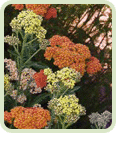 Zone 3 – 9 Zone 3 – 9Light: Full Sun Planting Date: SpringThis easy to grow perennial flowers the first year! The blooms are a sumptuous mix of fruity colours, from deep salmon-apricot with yellow ray florets, through to cherry-red with apricot ray florets, contrasted with the aromatic gray-green feathery foliage. Excellent for the border and as a cut flower, fresh or dried. Attracts butterflies and bees to the garden. Height is 27 inches. Spread 20 inches.Start indoors 4-6 weeks before planting out. Sow thinly and cover lightly with fine soil and keep moist. When large enough, transplant 5cm (2″) apart to further trays or pots of compost. Harden off at the end of May to avoid frosts and transplant 45cm (18″) apart into the flowering position in June. Enjoys full sun and can tolerate dry soils. |
| Angel Hair Grass [Stipa tenuissima]
|
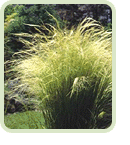 Hardy to Zone 5 Hardy to Zone 5Light: Full Sun Planting Date: Spring / FallThe finest textured of all grasses! Delicate hair-like filaments billow with every breath of wind. Loves sun. Height 24 inches, 12 inches wide. Often grown as an annual, but is hardy to zone 5.Sow inside 6-10 weeks before planting outside. Cover seed with 1/8 inch of potting mix and germinate at 20°C. Very easy to germinate in 2-3 weeks. Plant young plants outside after last frost date, 12 inches apart. Water well until plants are established. Grows 2 feet high. Prefers full sun and well-drained soil. Excellent in containers, just plant into the garden before winter. Cut back to ground level in early spring. Divide in spring every 3-4 years if desired. |
| Armeria [Armeria pseudoarmeria]
|
 Zone 5 – 9 Zone 5 – 9Light: Full Sun Planting Date: SpringThis hardy perennial will flower the first year adorning your garden with rich, long-flowering plants in mixed shades of white, red and lilac. Cushion-shaped grassy foliage and long-stemmed 11/2 – 2 inch globular blooms will enhance any border and look very attractive in cut flower arrangements. Height 24″.Start inside 8-10 weeks before planting out. Soak seed for 6-8 hours in warm water. Cover seeds lightly and provide a soil temperature 15-21°C. May also be direct seeded in early spring or early autumn. Transplant in early spring into a full sun location, 12″ apart. Likes well-drained, sandy soil that is not too rich. Tolerant of seaside conditions and drought. Deadhead throughout the summer and mulch during the winter. Dividing is not neccesary, but you can divide every 3 years in spring. |
| Aster [Aster alpinus, Aster novae-angliae – September Ruby]
|
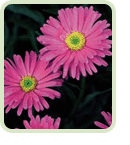 Aster alpinus: Zone 4 – 9 Aster alpinus: Zone 4 – 9Aster novae-angliae – September Ruby: Hardy to Zone 4 Light: Full Sun to Light Shade (see below) Planting Date: Spring / Fall (see below)Beautiful, large, intense pink coloured daisies (other varieties available). This rock garden favorite does best in well-drained, lean soils under full sun. ‘Pinkie’ asters can also be used in the front of the border or in containers. Easy to grow from seed. Start seed indoors 8 weeks before planting out. Height 12 inches.Aster alpinus: Start inside 6-8 weeks before planting out. Cover seed lightly and provide warmth (24°C). May also be direct seeded in early spring or late autumn. Germination usually takes 2-3 weeks. Transplant after last frost into a sun or light shade location, 12″ apart. Prefers well-drained, but moist soil. Water regularly. Divide every 3 years in spring.Aster novae-angliae – September Ruby: Sow seed inside 8-10 weeks before planting out. Lightly cover seed and germinate at 20°C. Seed should sprout within 2-3 weeks. Grow on seedlings in a bright but cool (13-15°C) location. Pinch back seedlings when they are 6 inches tall to encourage bushy growth. Transplant into a full sun location, 12-15 inches apart. Prefers average, well-drained soil. Divide every 3 years in spring. Height 4 feet. Prefers sun to part sun. |
| Balloon Flower [Platycodon grandiflorus]
|
 Zone 4 – 9 Zone 4 – 9Light: Full Sun to Light Shade Planting Date: SpringUnique double flowers! A compact perennial grown for its white and blue flowers. Flower buds are completely round and appear inflated, but suddenly open into wide-mouthed, upturned bells. Lovely in the summer border. Height 20 inches.Start seed indoors 6-8 weeks before planting outside, in peat pots. Sow seed on the surface, provide light and warmth and they should sprout in 15-30 days. Handle seedlings gently. Transplant outside in late spring into full sun or light shade. Prefers rich, moist well-drained soil. Water and deadhead frequently to prolong the bloom period. Plants are slow to recover after divided so it is best to start plants from seed. |
| Bellis [Bellis perennis]
|
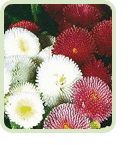 Zone 4 – 8 Zone 4 – 8Light: Full Sun to Partial Shade Planting Date: Spring / FallAlso known as English Daisy, this attractive, early blooming flower is ideal for borders or rock gardens. Tiny button-type blooms fully cover the dwarf small leafed plants. Mulch in the fall. Height 5 inches.Start inside 8-10 weeks before planting outside. Sow seed on surface, provide light and 21°C. Germination in 2-3 weeks. Will flower the first year if started inside in early spring. Sow directly outside from midsummer to early autumn for flowering the following year. Plant outside after last frost in full sun to part shade, 6-12 inches apart. Do not allow to dry out. Mulch lightly after ground is frozen in fall. Divide after flowering every 3 years. |
| Butterfly Bush [Buddleia davidii]
|
 Zone 5 – 9 Zone 5 – 9Light: Full Sun Planting Date: SpringAttracts Butterflies! Fragrant panicles of primarily lavender blooms appear in late summer. Some purple, white, blue or magenta plants may appear as well. Renowned for attracting a wide range of butterflies. Blooms and grows 3 feet in the first year. May eventually form a shrub 9’x9′.Start inside 8 weeks before last frost date. Sow seed on surface, provide light and bottom heat. Seed should germinate in 3 weeks. Plant outside after last frost date into a full sun location. If planting into a permanet location, space at least 3-4 feet apart. Good flower production will continue if spent blooms are removed. May be cut back close to the ground in fall or early spring. Blooms on new growth. Unpruned plants will bloom earlier in the summer than pruned plants. Moist, fertile limes soil, will produce the largest flower panicles. Enjoys lime applications. |
| Butterfly Flower [Ascelpias incarnata]
|
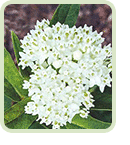 Zone 3 – 8 Zone 3 – 8Light: Full Sun to Light Shade Planting Date: SpringAttracts Butterflies! This is a must have for the butterfly garden! Commonly called milkweed, it is the exclusive diet of the Monarch caterpillar. We have, in fact, seen several caterpillars in our field trials! An impressive late summer flowering border plant. Flowers the first year. Milkmaid has white flowers (other colours available). Reaches a height of 40 inches by second year.Start inside 8-10 weeks before planting out, in peat pots. Cover seed lightly, provide light and cool conditions (10-24°C). May also be direct seeded outside in early spring or early autumn. Transplant when plants are still small in early spring. Space 24 inches apart in a permanent spot. These plants hate to be moved or divided. Full sun to light shade. Pinch back plants when 6 inches tall to encourage branching. |
| Campanula [Campanula carpatica, Campanula lactiflora]
|
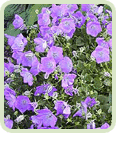 Campanula carpatica: Zone 3 – 8 Campanula carpatica: Zone 3 – 8Campanula lactiflora (Dwarf Pink): Zone 5 – 9 Light: Full Sun to Partial Shade (see below) Planting Date: SpringA hybrid perennial producing masses of long blooming, star-shaped bell flowers. The beautiful blooms of the Clips Series are very attractive in rock gardens and for borders. Height 6-12″.Campanula carpatica: Start inside 8-10 weeks before planting out. Sow on surface, provide light, warmth (21°C) and moisture. Should germinate in 2-3 weeks. Transplant outside in early spring, into full sun or part shade, 12″ apart. Shade is preferable if your summers are very hot. Enjoys limed soil, constant moisture, and deadheading. Divide every 3-4 years in spring.Campanula lactiflora (Dwarf Pink): First Year Flowering Perennial. Campanula has very small seed so care with sowing is essential. Start seed indoors 6-8 weeks before last frost date. It is not necessary to cover the seed. Propagate at 15 to 18°C. Germination should take place in 2 to 3 weeks. Campanula seedlings can be slow to develop so ensure that they are not over watered. Maintain a temperature of 15°C after germination until seedlings are established. Shade seedlings slightly from direct sunlight to prevent scorching. Plant out after last frost date 90 cm (35″) apart. Can be divided every 3-4 years in spring. |
| Chinese Lanterns [Physalis alkekengi]
|
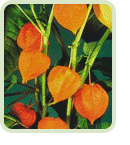 Zone 3 – 9 Zone 3 – 9Light: Full Sun to Partial Shade Planting Date: SpringEverlasting Hardy perennial sometimes called Winter Cherry or Strawberry Tomato. Bright orange ‘little lantern’ shaped flowers. Height 18 inches.Start inside 6-8 weeks before planting out. Do not cover seed, provide light and warmth. Seed may take up to 30 days to germinate. May also be direct seeded outside in spring. Transplant into the garden after last frost into a full sun or part shade location, 12-24″ apart. Grows well in average, well-drained soil. Water regularly and cut stems to the ground in fall. May be divided every 3 years in early spring. |
| Columbine [Aquilegia sp.]
|
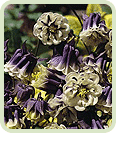 Zone 3 – 9 Zone 3 – 9Light: Full Sun to Partial Shade (see below) Planting Date: SpringStunning late spring-flowering perennial boasts unusual double pleated flowers in sky-blue and white. Double Pleat Blue and White Columbine will continue to bloom until late summer. Use in clumps in the border and mixed bed. Height 24 inches.Start inside 8-10 weeks before planting out, as germination can be slow. Sow seed on the surface and prechill in the refrigerator for 5 days. Bring containers out and provide light and a soil warmth of 24°C (75°F). Seedlings are very delicate. Water gently and keep out of hot, midday sun. Transplant outside after last frost, 6-18″ apart. Provide part shade if summers are hot. Will tolerate full sun if summers are cool and they have constant moisture. Deadhead regularly. Often self-seeds. |
| Coreopsis [Coreopsis grandiflora]
|
 Zone 3 – 9 Zone 3 – 9Light: Full Sun to Light Shade Planting Date: SpringDwarf, compact plants require little care and bloom all summer. Brilliant 21/2″ semi-double rich golden yellow blooms. Height 24-26″.Start inside 6-8 weeks before last frost. Sow on surface, provide light and cool to warm temperatures (13-21°C). May also be direct seeded into the garden after last frost. Keep moist. Transplant into the garden after last frost into a full sun to light shade location, 12″ apart. Provide well-drained soil, do not overfertilize, and deadhead regularly. Tolerates poor, dry soils. |
| Painted Daisy [Tanacetum coccineum]
|
 Zone 5 – 9 Zone 5 – 9Light: Full Sun Planting Date: Spring / FullA striking mix of large 2″ daisy-like rose and red flowers borne singly on long stalks above attractive feathery foliage. Perfect for borders, edging, or wildflower gardens. Height 30″.Contains pyrethrum, a chemical that is commonly used as an organic insecticide. To make your own, crumble fresh or dried flowers into water and let it sit for a day or two. Strain and use to control aphids and other soft-bodied insects. Start inside 8-10 weeks before planting out. Cover seed lightly and keep cool. May also be direct seeded into the garden in early spring or early autumn. Pinch back young plants to encourage branching. Hardened plants may be transplanted in early spring, into a sun location, 18 inches apart. Plant in groups of at least three plants. Divide every 3 years or when the center starts to die out in spring. After blooming, cut back foliage by half. Deadhead regularly. |
| Pansies and Violas [Viola tricolor, Viola x wittrockiana]
|
 Zone 4 – 8 Zone 4 – 8Light: Sun (see below) / Partial Shade Planting Date: Spring / FallUsually sold and grown as annuals, but often overwinter dependably. Johnny Jump Ups and Violas (V. tricolor) are usually hardier than the larger flowered Pansies. Start inside 8 weeks before planting out. Lightly cover seed, provide total darkness and normal room temperatures. Should germinate in 10-20 days. May also be direct seeded into the garden in early spring or early autumn. Transplant outside in early spring into a part shade location. Only plant in full sun in areas with cool summers. Very frost tolerant and prefers cool, moist conditions. Provide rich, moist well-drained soil. A mulch is often helpful. Deadhead regularly to ensure that plants bloom all season. Self-seeds. |
| Penstemon [Penstemon hybrid, Penstemon barbatus, Penstemon digitalis]
|
 Penstemon hybrid: Zone 5 – 9 Penstemon hybrid: Zone 5 – 9Penstemon barbatus: Zone 4 – 9 Penstemon digitalis: Zone 3 – 8 Light: Full Sun to Very Light Shade (see below) Planting Date: Spring / Fall (see below)Loose spikes of tubular rosy-lavender blooms cover bushy plants for most of the summer. Blooms the first year, 12 weeks from seed. Excellent in large patio pots or in the border. 24″ high and 18″ wide.Penstemon hybrid: Sow seed 8 weeks before last frost date. Sow seed on surface; provide light and average room temperatures. Seed usually germinates in 3 weeks. May also be direct seeded in spring or autumn. Plant outside after last frost date, 12 inches apart in a full sun or very light shade location. Prefers well-drained fertile soil. Use winter mulch if planted in an exposed area. Often short-lived and may have to replaced in 3-4 years. May be damaged by slugs.Penstemon barbatus & Penstemon digitalis: Sow indoors, in mid-spring, onto the surface of moist soil. Cover lightly with vermiculite or soil. Propagate at 15-18°C (60-65°F). Light is required for germination. Germination should take place in 10-14 days. Maintain a soil temperature of 15°C (60°F) after germination. Use near the back of mixed perennial borders. Height is 3-4 feet (90-120cm). Flowers in late summer. |
| Poppy – Pizzicato [Papaver sp., Papaver orientale, Papaver nudicaule]
|
 Zone 3 – 8 Zone 3 – 8Light: Full Sun Planting Date: Spring / Fall (see below)A semi-dwarf mixture of red, scarlet, orange, salmon, mauve, rose, pink and white blooms with black centers. 3-4 inch flowers are held on strong 24 inch tall stems which withstand strong winds.Papaver sp. & Papaver orientale: May be started inside 6-8 weeks before last frost in peat pots. Do not cover seed and provide cool conditions of 13°C (55°F). Often preferable to direct sow in early spring or late autumn, since poppies dislike transplanting. Transplant after last frost to a full sun location, 12-24 inces apart, depending on variety. Prefers well-drained, rather poor soil. Water regularly, but do not fertilize or use manure. Deadhead after blooming to prevent self-seeding, if desired. Iceland poppies do not need to be divided. Divide Oriental poppies only after they lose vigor from overcrowding. Move them in late summer after flowering has finished and the leaves have turned yellow.Papaver nudicaule: Sow seed indoors 6-8 weeks before last frost, in peat pots. Gently press seed onto surface of soil and germinate at 10-15°C (50-60°F). Seed should germinate in 10-20 days. Move plants outdoors to a sunny location after frost has passed in spring. Plants will self-seed unless deadheaded. Poppies form a taproot and are not easily moved. If you must transplant, do so carefully in the fall or early spring, when the plant lies dormant. |
| Potentilla – Monarch’s Velvet [Potentilla thurberi maorubens]
|
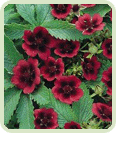 Zone 5 – 8 Zone 5 – 8Light: Full Sun Planting Date: SpringTruly a regal plant with velvet crimson and red single bicolor flowers, ‘Monarch’s Velvet’ is particularly long lived. Flowers the first year. Unlike typical potentilla shrubs, this is a herbaceous perennial, dying back to the ground each year. Prechill seed to 5ºC for 3 weeks before sowing. Height 24-30″.Long-lived perennial. Pre-chill the seed to 5°C (40°F) for three weeks before sowing. Start seeds indoors eight to ten weeks before last frost. Cover the seed lightly with vermiculite and propagate at 15 to 20°C (59-68°F). Seeds should germinate in 3 to 4 weeks. Grow the seedlings on at 10 to 15°C (50-59°F). Plant out after fear of frost is past, into a full sun location, 18 inches apart. Prefers well-drained, average soil. Can be divided every 3-4 years in spring or fall. |
| Rose (from seed) [Rosa chinensis minima]
|
 Zone 5 – 9 Zone 5 – 9Light: Full Sun Planting Date: SpringMay overwinter in zones 3 and 4 with protection. Start inside 8-12 weeks before planting out. Germinate at 15°C (59°F) for 30-60 days. Lightly cover seed and provide light. Germination may be erratic. This rose flowers when very young. Plant out after last frost or when plants are hardened off. Prefers full sun and well-drained soil, rich in organic matter, pH 6-6.9. Plant in full sun location 18″ apart. You can also grow as a container plant, but the container must be protected over the winter. Deadhead regularly and prune in spring or fall. Fertilize once a month with a balanced fertilizer. Generally pest free, but may be susceptible to mildew and spider mites if stressed. Mulch after the ground freezes. Can only be grown inside if you can provide at least 4-6 hours of direct sunlight per day all year. This means providing florescent lights in winter. Normal room temperatures are fine. You can bring container plants inside to enjoy blooms and then put them back outside. |
| Rudbeckia (Goldsturm) [Rudbeckia fulgida – Goldsturm]
|
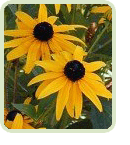 Zone 4 – 8 Zone 4 – 8Light: Full Sun Planting Date: SpringA bold, dependable perennial with golden-yellow flowers. Blooms July-October on sturdy stems. Easy to grow and perfect for a long lasting cutflower. Mass in borders with ornamental grasses and other late blooming perennials. A durable, low maintenance, pest-free plant. Height 18-30 inches.Long-lived and dependable. Start seed 10-12 weeks before last frost date. Press seed onto surface of mix; do not cover with soil. Give seed a cold treatment of 2-4°C (37°F) for 2 weeks. Just put moist tray in a sealed plastic bag and place in your refrigerator. Seedlings should be grown cool if possible and given lots of light. Plant into a sunny garden 18 inches apart. Clumps may be divided after 3-4 years in spring. Blooms July to October. |
| Salvia – Purple Volcano [Salvia lyrata]
|
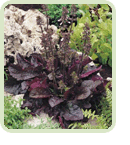 Zone 5 – 8 Zone 5 – 8Light: Full Sun to Partial Shade Planting Date: SpringImpressive foliage plant produces bronze-purple leaves year round and flower spikes all summer. The colour of the foliage intensifies during late summer and autumn to a deep purple. Purple Volcano is an excellent foliage perennial for use in borders. Height 10 inches.Start seed inside 6-8 weeks before planting outside. Germinate at 20°C (68°F), provide light and do not cover seed. Just press seed into soil surface. Will usually germinate in 1-3 weeks. Do not over-water and use a fungicide if you notice problems with ‘damping off’. Transplant after last frost or earlier if you wish to harden the plant off. Grows 8-10″ high. Space 12″ apart in a part shade to full sun (in cooler climates with mulched, moist soil) well-drained location. May be divided every 3-4 years in spring. |
| Saponaria – Hellas Rose [Saponaria ocymoides]
|
 Zone 3 – 8 Zone 3 – 8Light: Full Sun to Light Shade Planting Date: Spring / FallAlso known as Rock Soapwort. A profusion of tiny rose pink star-shaped flowers is produced endlessly all season. Trailing plants have vigourous neat and uniform growth which will cascade freely over rocks, garden walls and planters. Height 8-10 inches.Start inside 8 weeks before planting out. Do not cover seed, provide light and warmth of 21°C (70°F). Should germinate in 2-3 weeks. May also be direct seeded into the garden in early spring or early autumn. Transplant in early spring into a full sun or light shade location, 12 inches apart. May become invasive in rich, moist soil, but is easier to control in dry, rocky soil. Cut back after blooming to encourage reblooming. May be divided in early spring after 3-4 years. Do not overfeed. |
| Scabiosa [Scabiosa caucasica]
|
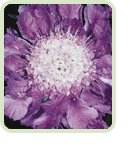 Zone 3 – 9 Zone 3 – 9Light: Full Sun Planting Date: SpringOne of the most popular perennials worldwide, pincushion flowers bloom all summer and are outstanding! Domed, lace-edged flowers about 3″ across with a 1½” disc of silvery white. Superb shades of lavender and blue on long, wiry stems. Height 24-36″.Start inside 8-10 weeks before planting out. Cover seed lightly and provide warmth of 21-24°C (70-75°F). Should germinate in 10-15 days. May also be direct seeded in early spring. Transplant hardened plants into the garden in early spring. Space 12-18″ apart in a full sun location. Prefers a moist, well-drained soil rich in organic matter. The addition of lime is beneficial. Deadhead regularly. Divide every 3-4 years in early spring. Provides a very long-lasting cutflower. |
| Sedum – Stonecrop [Sedum acre, Sedum spurium]
|
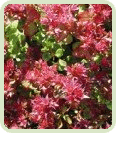 Zone 4 – 9 Zone 4 – 9Light: Full Sun Planting Date: Spring / FallThis blend of low growing hardy sedum, is perfect for rock gardens, rock walls, troughs, or as a ground cover. This mix includes Dragon’s Blood Sedum which has reddish green leaves and rosy-red flowers in summer, ‘Voodoo’ sedum, which has intense bronze leaves and scarlet flowers, and “Golden Carpet” sedum which has bright yellow flowers in late spring. Very drought tolerant and vigourous. Height 2-6″Start inside 6-8 weeks before planting out. Sprinkle seed on surface and germinate in darkness for up to 3 weeks. Provide cool to average soil temperatures. May also be direct seeded in early spring or autumn. Plant out transplants around last frost date at least 12 inches apart. Will quickly spread and may be divided in spring or fall. Enjoys full sun and can withstand drought. Do not over water or fertilize. Cuttings root easily. Deadhead regularly. Perfect for Rock Gardens. |
| Shasta Daisy – Snow Lady [Leucanthemum x superbum]
|
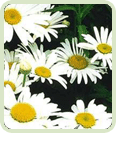 Zone 5 – 9 Zone 5 – 9Light: Full Sun Planting Date: Spring / FallA hardy hybrid perennial that will flower the first year from seed. Pure white 2-3 inch blooms with a contrasting yellow eye. Dwarf plants. Great for beds or rock gardens. Height 10-12 inches.Start inside 6-8 weeks before planting out. Do not cover seed, provide light and average temperatures,21°C (70°F). May also be direct seeded into the garden in early spring or late autumn. Transplant after last frost into a full sun location, 12 inches apart. Prefers, rich, deep, well-drained soil. Water and deadhead regularly. Shear after blooming. Divide in early spring every 2-3 years. |
| Snow in Summer [Cerastium tomentosum]
|
 Zone 3 – 7 Zone 3 – 7Light: Full Sun Planting Date: Spring / FallA beautiful perennial floral carpet with an abundance of pure white 1/2 inch flowers on spreading silver leafed plants that can reach a height of 30 inches. Blooms early in May and June. Snow in Summer is perfect for rockeries, terraces or slopes where other plants will not do well.Start inside 6-8 weeks before planting out. Cover seed lightly and provide average soil warmth of 18-21°C (65-70°F). Should germinate in 5-15 days. May be direct seeded outside in early spring or late autumn. Transplant after last frost into a full sun location, 12-24 inches apart. Grows well in part-shade but will not bloom as heavily. May become invasive if not kept in check. Shear after blooming to keep plants tidy. Divide in spring when plants are too large. Grows well in hot, dry sites and poor soil. |